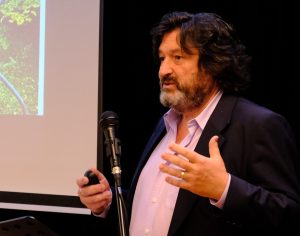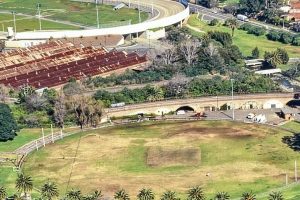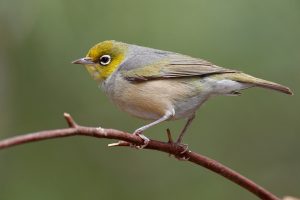By Andrew Wood, Blue Wren Subcommittee, Bulletin 4/2024, June
Updates about the Innovation and Ideas Grant

Professor Dieter Hochuli, leader of the University of Sydney’s Integrative Ecology Group, who is undertaking the research project titled ‘Glebe’s Hill – unravelling its biodiversity secrets and potential’, reports that:
Genevieve Heggarty (the research assistant employed by the Grant) and I set up four cameras on the Hill, and made some observations along the away (some very happy silvereyes and a grey fantail there among the lantana, more garden skinks than we could count in the bits we went to, it was like the ground was moving, and some interesting poo). I let the City of Sydney (via Cathy from Colliers) know the work was on and we were going as per the approval.
We also added two cameras at just north of the main bit of Orphan School Creek to repeat a couple of things that relate to Genevieve’s BSc honours work. We couldn’t set any up near Federal Park as there is someone sleeping there at the moment but will revisit if/when he moves on.

We’re also getting a bit more of a database together of exemplars for using degraded/polluted/contaminated lands for urban conservation. It’s an odd collection globally (the Australian examples are mainly garbage tips being capped and planted) but I think it will offer some options and opportunities.
Here are some comments on Dieter’s report from Judy Christie:
It is very encouraging to see that small birds are finding suitable habitat around ‘The Hill’ and in patches of dense lantana, well-known to be a safe haven for small birds.
Silvereyes were once common in Glebe gardens and parks, but much less so over the last 20 years. They are quite nomadic and at this time of the year are moving north, as are breeding populations from Tasmania, which can be distinguished by their chestnut brown flanks. Grey Fantails are a cute little bush bird but are rarely seen in our suburbs. However, they also move around at this time of the year, especially birds dispersing after breeding. Although Superb Fairy-Wrens are more local and do not usually move more than a few kilometres from breeding sites, their habitat requirements are similar to these small birds. Creating dense, protective habitat ‘stepping stones’ along our green corridors may help bring them back.

Also, there is a recent article on the Birds in Backyards website about the outcomes of Genevieve Heggarty’s wren research. It was work she completed last year for her honours thesis which was supervised by Dieter.
News from the bushcare groups
Twelve bushcare volunteers attended a planting day held by the Orphan School Creek Bushcare Group (led by Judy Christie) on 13 April and planted 48 native tube stock. On 9 May an onsite meeting was held with the Charlotte Fletcher, the City’s recently appointed Urban Ecology Coordinator – it was the first time Charlotte had met with the volunteers. On Saturday 1 June a working bee will be held from 9 am to 11 am and those wishing to attend should contact Judy on 0437 693 372.
Anna Szanto, leader of the Glebe Palmerston and Surrounds Landcare Group, reports that:
- The graffiti that’s been gouged into the edge of the path on upper Palmerston has been reported to the City.
- During a recent storm one of the trees at the bottom of upper Palmerston was badly damaged. The State Emergency Service came and cut the limbs up and placed them on the gardens, damaging the native plants at the bottom of upper Palmerston and the top of lower Palmerston. The City has now removed most of the damaged limbs. The uprooted trunk and a part of the root system is still in situ – the City has been asked to remove them.
- Upper Palmerston is still taped off due to possible asbestos contamination.
- Overall, the native plants are thriving, and weeding and litter removal continue in lower Palmerston.
Nick Sangster reports that in Harold Park the Casuarinas on the eastern side of Johnstons Creek have still not been removed by the City’s contractors. As described in last month’s Bulletin, the problem posed by the Casuarinas is that as they sucker and grow. This kills off other plants; in time, they create a monoculture that diminishes plant and animal biodiversity.








There are no comments yet. Please leave yours.